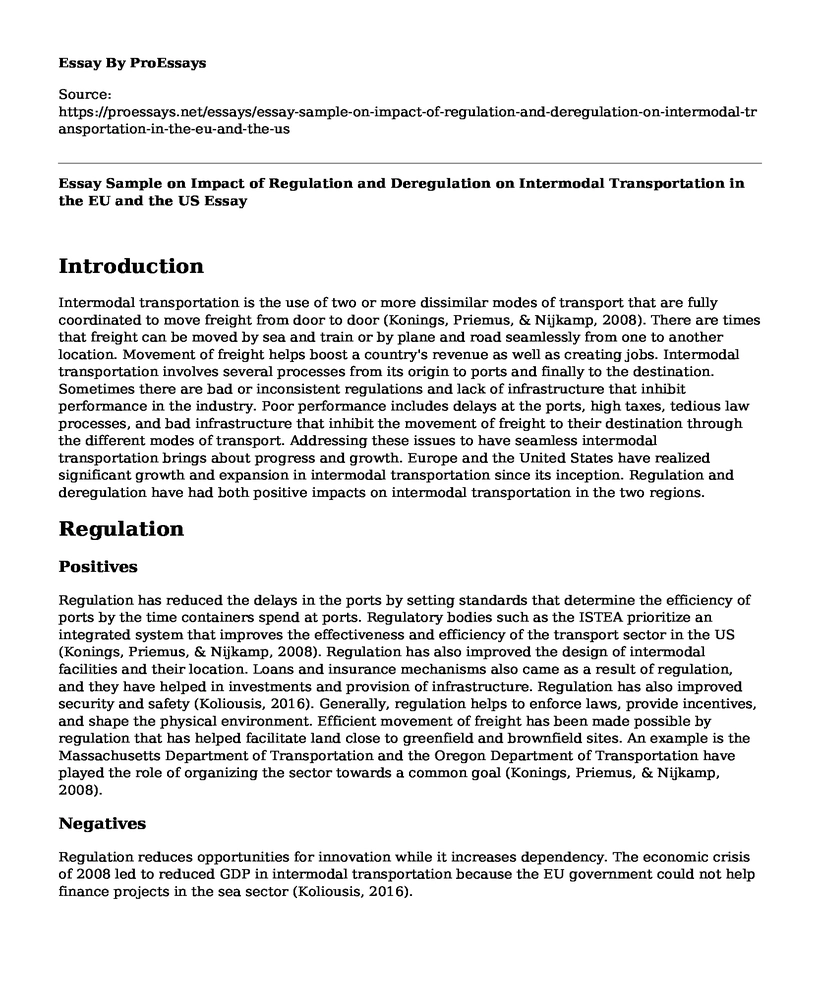Introduction
Intermodal transportation is the use of two or more dissimilar modes of transport that are fully coordinated to move freight from door to door (Konings, Priemus, & Nijkamp, 2008). There are times that freight can be moved by sea and train or by plane and road seamlessly from one to another location. Movement of freight helps boost a country's revenue as well as creating jobs. Intermodal transportation involves several processes from its origin to ports and finally to the destination. Sometimes there are bad or inconsistent regulations and lack of infrastructure that inhibit performance in the industry. Poor performance includes delays at the ports, high taxes, tedious law processes, and bad infrastructure that inhibit the movement of freight to their destination through the different modes of transport. Addressing these issues to have seamless intermodal transportation brings about progress and growth. Europe and the United States have realized significant growth and expansion in intermodal transportation since its inception. Regulation and deregulation have had both positive impacts on intermodal transportation in the two regions.
Regulation
Positives
Regulation has reduced the delays in the ports by setting standards that determine the efficiency of ports by the time containers spend at ports. Regulatory bodies such as the ISTEA prioritize an integrated system that improves the effectiveness and efficiency of the transport sector in the US (Konings, Priemus, & Nijkamp, 2008). Regulation has also improved the design of intermodal facilities and their location. Loans and insurance mechanisms also came as a result of regulation, and they have helped in investments and provision of infrastructure. Regulation has also improved security and safety (Koliousis, 2016). Generally, regulation helps to enforce laws, provide incentives, and shape the physical environment. Efficient movement of freight has been made possible by regulation that has helped facilitate land close to greenfield and brownfield sites. An example is the Massachusetts Department of Transportation and the Oregon Department of Transportation have played the role of organizing the sector towards a common goal (Konings, Priemus, & Nijkamp, 2008).
Negatives
Regulation reduces opportunities for innovation while it increases dependency. The economic crisis of 2008 led to reduced GDP in intermodal transportation because the EU government could not help finance projects in the sea sector (Koliousis, 2016).
Deregulation
Positives
Deregulation has encouraged innovation such as the container revolution (Koliousis, 2016). It has also helped to increase competitiveness in the industry resulting in affordable and efficient transportation services. Competition in the rail, motor carrier, maritime and aviation industries in the past decades has led to the increase in the volumes of freights. The Airline Deregulation Act of 1978 created opportunities for commuter airlines whose operations were overshadowed by the large commercial airlines (Konings, Priemus, & Nijkamp, 2008). Deregulation in the EU has led to the expansion of the road transport sector since it reduced the entry and operational restrictions.
Negatives
Deregulation in the United States between 1979 and 1983 lost the US carrier industry over $1 billion petroleum hikes in an unregulated market (Konings, Priemus, & Nijkamp, 2008). There is also unfairness in the industry when there is deregulation that encourages monopolies. Deregulation has reduced the services that reach small communities. For example, airlines have preferred to explore the lucrative markets instead of serving smaller markets (Koliousis, 2016).
Conclusion
Regulation and deregulation have both enhanced the growth of intermodal transportation in the EU and the US. Competitive market forces have shaped the industry that was previously highly regulated. Technology advancements have come up as a consequence. Efficiency has also improved as well as diversification. However, the constraints for intermodalism have resulted from the proliferation of alternatives. Nonetheless, guidelines, safety, coordination have all been prevalent due to the efforts of regulation.
References
Koliousis, I. (2016). Assessing the Impact of the Latest Deregulatory Developments in the EU28 Transport Industry Production: A Critical Review Based on Empirical Data. Journal of Economics and Business, 66(1-2), 3-2.
Konings, J. W., Priemus, H., & Nijkamp, P. (2008). The future of intermodal freight transport: Operations, design, and policy. Cheltenham: Edward Elgar.
Cite this page
Essay Sample on Impact of Regulation and Deregulation on Intermodal Transportation in the EU and the US. (2022, Dec 14). Retrieved from https://proessays.net/essays/essay-sample-on-impact-of-regulation-and-deregulation-on-intermodal-transportation-in-the-eu-and-the-us
If you are the original author of this essay and no longer wish to have it published on the ProEssays website, please click below to request its removal:
- Issues to Be Addressed by United Nations Regarding Poland Paper Example
- The International Organizations in Asia as a Sources of Stability Essay
- Research Paper on China's Growing Influence in Africa: Impact on US Trade
- Essay Example on Small Nations Profit From UN Peacekeeping Missions
- Essay Sample on IKEA: Unique Retail Business Model of the Most Internationally Successful Furniture Retailer
- Essay on Amazon: From Incorporation in 1994 to World's Biggest Online Retailer
- Trade Wars: Impact on Global Businesses and Governments - Essay Sample







